Creag Ghuanach
This is the final part of Gemma’s epic six-part series on land, language, wilderness and belonging … read the full series here.
Creag Ghuanach is the name of the sylvan one: green, leafy, wooded, the high beautiful hillock of hunting, and it’s far she is from shellfish. Creag mo chridhe-sa Creag Ghuanach, Creag an d’ fhuaras cuid d’ a h-àrach: ‘Rock of my heart, Creag Ghuanach, Rock from which I got some of her nurture’. Creag nan aighean ‘s nan damh siùbhlach, ‘S i a’ chreag iùlmhor, fhonnmhor, fheurach: ‘Rock of the hinds and the speedy stags, She’s the prominent, inspiring, grassy rock.’ Creag Ghuanach is a distinctive craggy hill at the south end of Loch Treig, topographically lying east of Ben Nevis and north of the Blackwater Reservoir, and figuratively at the centre of the 16th-century epic Gaelic poem ‘Oran na Comhachaig’ or ‘Song of the Owl’. Attributed to the poet and hunter Dòmhnall mac Fionnlaigh nan Dàn (‘Donald, son of Finlay of the poems’), the poem is comprised of an extended dialogue between a hunter and an owl, who pay tribute to the landscapes of their youth and lament the passing of time. It is not however an elegy, more a celebration of the cycles of history and life that made the place meaningful. Dòmhnall mac Fionnlaigh was head deer stalker and bard to the chief of the Macdonalds of Keppoch, whose territory this once was. He lived at Fersit near the north end of the loch, spending his summers down at Creag Ghuanach. The Macdonalds were said to have a preference for upland territories, as the jibe about shellfish references – shellfish was the food of poor people, beneath those with access to the riches of the forests and glens. According to one of many local legends about him, the bard acquired his hunting prowess through a deal with The Cailleach of Beinn a’ Bhric, who in place of letting him steal her favourite white hind, instead agreed to take away the local deer’s sense of smell, so that neither hind nor deer from that day henceforth ever got wind of Dòmhnall mac Fionnlaigh. He is said to be buried either in Cille Choirill graveyard, near Spean Bridge, or as he requested, wrapped in a deer hide on a hill overlooking Loch Treig, so that the deer and their calves could rest by his side.
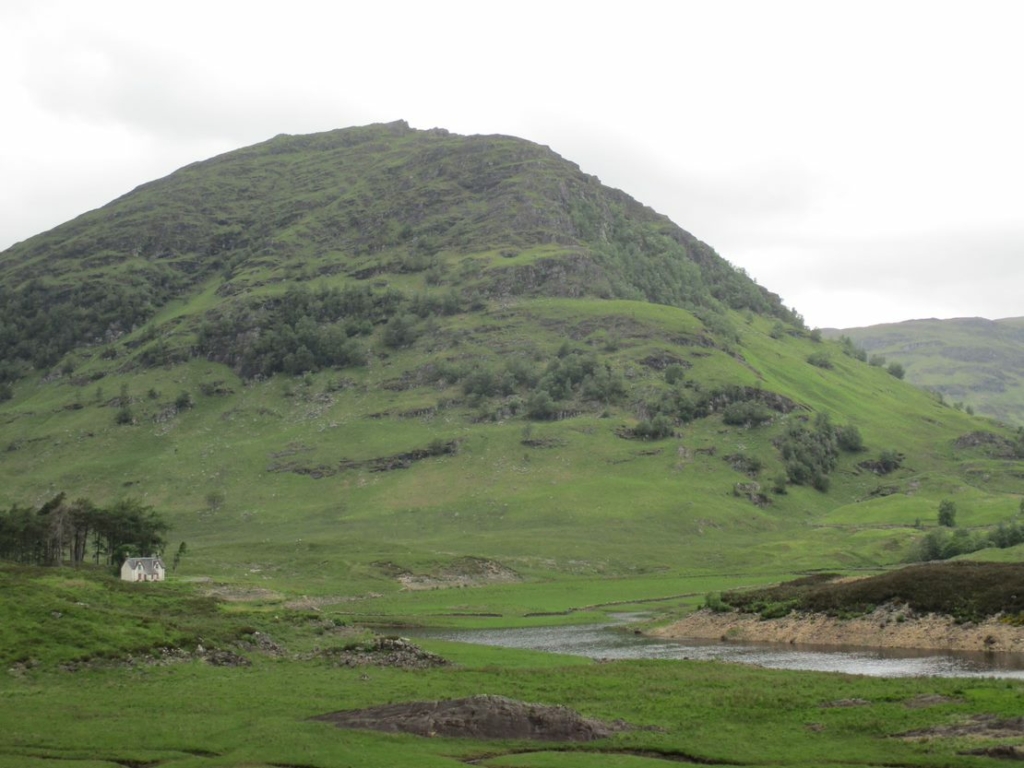
Creag Ghuanach itself, and the semi-derelict Creaguaineach Lodge (photo by author)
The name Creag Ghuanach has a number of possible meanings. Creag means ‘crag’ or ‘rock’, but there are competing explanations for the specific element. It is unclear whether the word starts with a ‘g’ sound or not. If you ask an estate employee in the area, they will most likely tell you the name is from uanag, ‘wee lamb’, or uanach, ‘abounding in lambs’. Either way this means the name would mean something like ‘lamb crag’. The contemporary spelling of the name would instead give us guanach, according to Dwelly’s dictionary meaning ‘unsteady, nodding, wavering’. He lists the phrase, ‘air a’ chreig ghuanaich, on the nodding rock’, although he may have taken this from the first transcriptions of the well-known poem itself from the 18th century – rocks by nature don’t tend to do much nodding, unless you’ve been looking at them for a very long time. The 1873 OS six inch first edition map has Creag Uaine, ‘green crag’ – although this is appealing given the description in the poem and the leafy appearance of the place today, uaine is very rarely used to describe vegetation in Gaelic place-names. More common is gorm, which usually means ‘blue’, but extends also to cover greens at the deeper, more verdant end of the spectrum. Another theory is that the name comes from the same element that gives us the place-name of the village Onich, just over at Loch Linnhe: omhanach, ‘frothy, abounding in froth of milk or whey’. This is perhaps supported by an early 18th century description of Loch Treig by Walter Macfarlane, who says that ‘there is abundance of milk in this Logh in summer harvest and spring tyme. There is no corne lands in this Logh but onlie guid for pasture and feeding of guids [cattle].’ Each one of these interpretations could be said to have been ‘correct’ at various points in time.
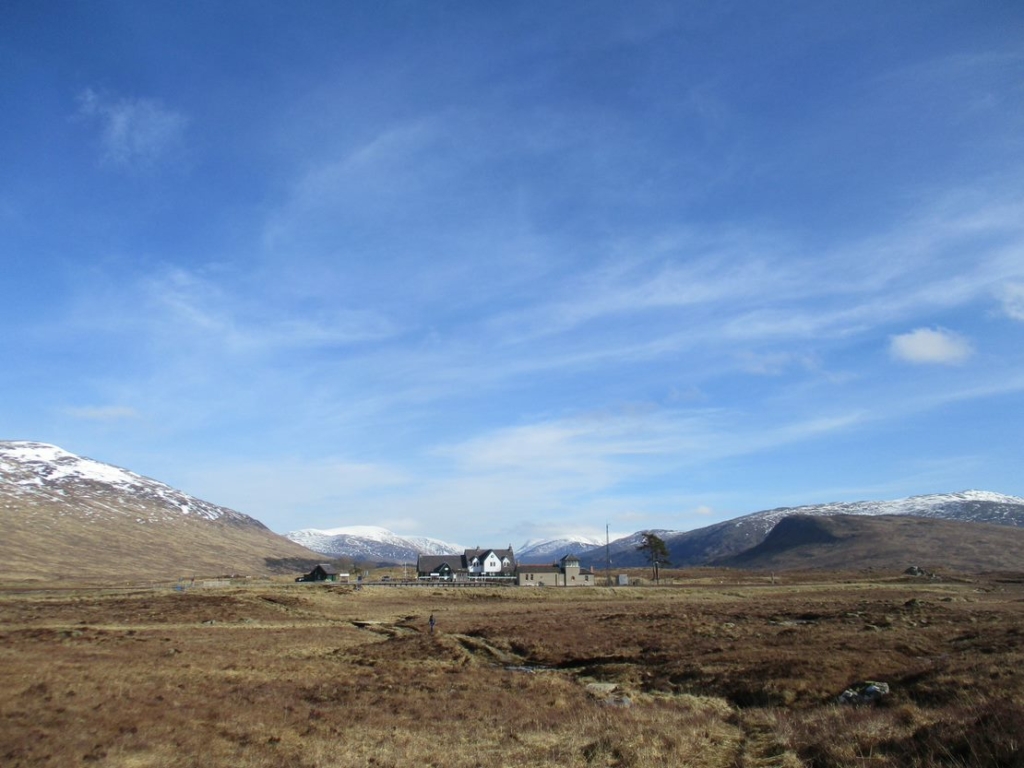
Corrour Station (photo by author)
The quickest route to Creag Ghuanach is via the train to Corrour. Corrour is the ‘middle of nowhere’ station on the West Highland Line, far from any roads, where in the film version of Trainspotting Tommy takes the unimpressed Renton, Spud and Sick Boy for a walk. If you look on Google maps, the small, unremarkable wooden footbridge on the other side of the tracks where Renton makes his famous ‘it’s shite being Scottish’ speech is now marked as ‘Trainspotting Bridge’. The train station and the hostel just a mile down the path make this actually a relatively low-effort place to visit when you want to get away from everything in the winter, as I first did one February in a spell of clear, sunny weather. I arrived at Corrour Station to bright blue skies and a dusting of snow on the tops, and set off up the hill path to the south to investigate the ruins of the original Corrour Lodge. The name Corrour – from coire odhar, ‘dun-coloured corrie’ – originally came from this location, about 550m above sea level up a rather bleak hillside on the track to Rannoch Station. The stark remains of the plain, almost brutalist-looking early 19th-century structure look out over moorland to the Blackwater Reservoir. On such a freezing and windswept day, it was like peering into an enormous volcanic crater.
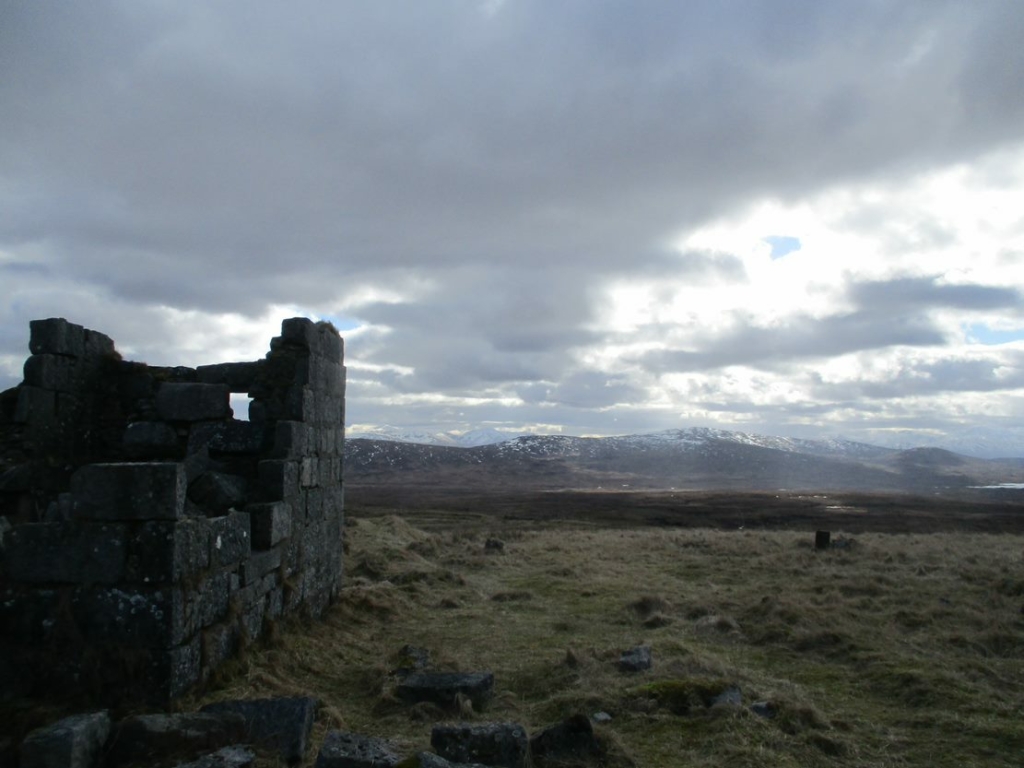
Corrour Old Lodge (photo by author)
Being a jessie about winter camping, I was very glad to get back to the hostel and the warmth of the wood-fired stove. The sugar-pink snowy sunset and bright starry skies were no less beautiful for the knowledge I had a cosy place to return to when I could no longer feel my toes. The next morning I wiped condensation from inside the window of the kitchen to watch the sole camper clamber down the lochside and break the ice to fill his kettle with water, and wondered how on earth a person keeps warm all night in a tent in February. The sun came up and flooded the landscape with light as crisp and fresh as the nip in the air. By the time I’d made it halfway along the track that loops around Loch Ossian the wind had broken up the ice, and driven countless shards of it down the water until they crashed together in waves against the distant shore, jangling like a thousand glass wind-chimes.
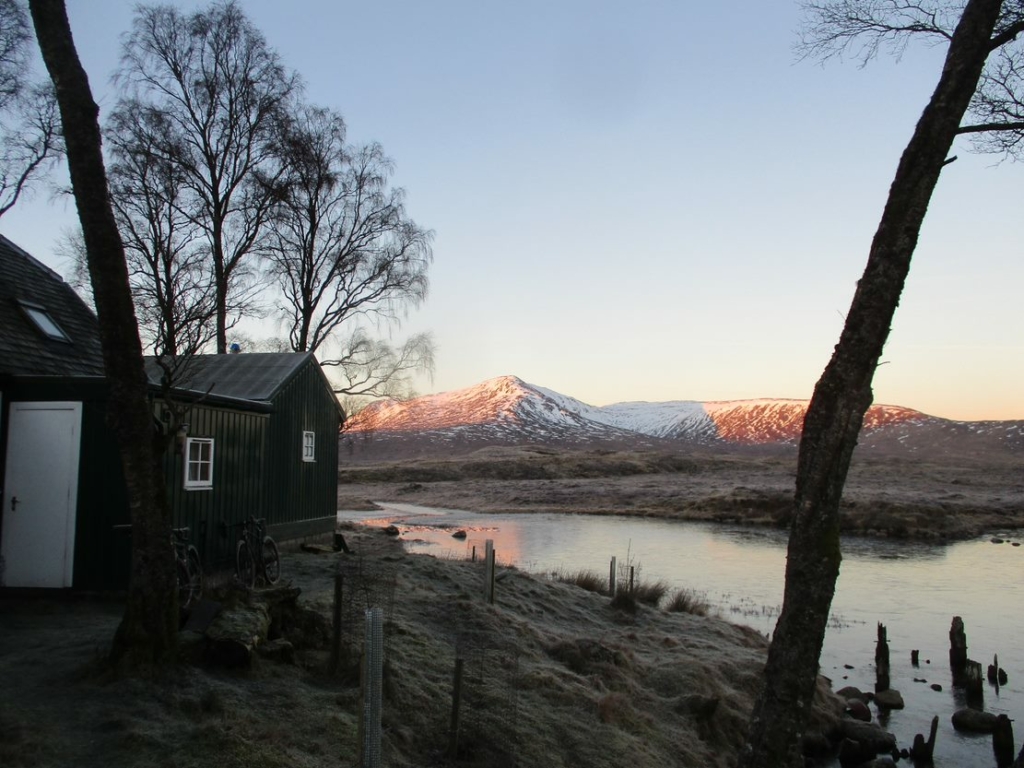
Loch Ossian Hostel, Leum Uilliem (‘William’s leap) in the background (photo by author)
Located so near to a Victorian hunting lodge, I’d assumed that the place-name of Loch Ossian – so-called after the warrior-poet son of Fionn mac Cumhaill – had probably come about due to a sprinkling of 19th-century Celtic mist. It was only after seeing it mentioned in ‘Oran na Comhachaig’, and finding another 16th-century reference to Loch hoshing on Timothy Pont’s map, that I realised that this was a legitimate Fenian place-name. In what the great Gaelic scholar John Macinnes called its ‘heroic roll-call’ of place-naming, the poem mentions Srath Oisean a’ chruidh or ‘Strath Ossian of the Cattle’, and the strath at the north end of the loch is the location of one of my favourite sets of shieling place-names. On the OS map you will see here Ruighe Shomhairle, ‘Sorley’s shieling’ and Lùb Shomhairle, ‘Sorley’s river bend’ right next to a Ruighe Alasdair, ‘Alasdair’s shieling’ and Lùb Alasdair, ‘Alasdair’s river bend’; I like to think Sorley and Alasdair were perhaps two brothers, who could stand working together so little that they split the family shieling in two, even reserving different bends of the river for fishing. The conflation of hunting and transhumance landscapes indicated in the line from the poem show how these two activities were not always considered to be mutually exclusive; the hunting forests of the Gaelic past were far removed from the empty, denuded landscapes we associate with such places today.
All you will find these days at the east end of Loch Ossian is the strikingly modern New Corrour Lodge and its associated outbuildings and estate workers’ cottages. Built by Lisbet Rausing – daughter of Hans, one of the heirs to the enormous Tetrapak fortune, who made £4.5bn from the sale of his share in 1996 – the £20m lodge was heralded by a Times headline in 2003, ‘Heiress brings fantasy to the glens’. In November of that year Torcuil Crichton and Andy Wightman wrote in The Herald of how in a completely legal series of transactions Corrour changed hands between three companies in Scotland and the Cayman Islands in four months, resulting in £24.8m entering the UK free from any tax liability, with ultimate ownership of the estate remaining with the Rausings. According to Loyd & Townsend Rose Exceptional Castle Experiences, the lodge can be hired for £25,000 + VAT for two nights and three days for up to fourteen adults (not including activities or wine and spirits), and it features in episode three of Channel 4’s lifestyle show, Extraordinary Escapes with Sandi Toksvig. In 1998, three years after purchasing the estate, Lisbet wrote Corrour: A History of a Sporting Estate, in which the Harvard-educated historian argues that ‘it is probable that the area never had a permanent human population’, due to its ‘harsh climate and its high altitude’, and that its seasonal use in shieling practice was marginal, meaning that Corrour was ‘not affected by land clearances’. Although she mentions ‘Donald MacFinlay, the hunter-bard of Fersit’, she does not seem to be aware of the poem ‘Oran na Comhachaig’ itself, and dismisses ‘the pseudo-Ossianic lore’ of Lochaber as ‘invented traditions’.
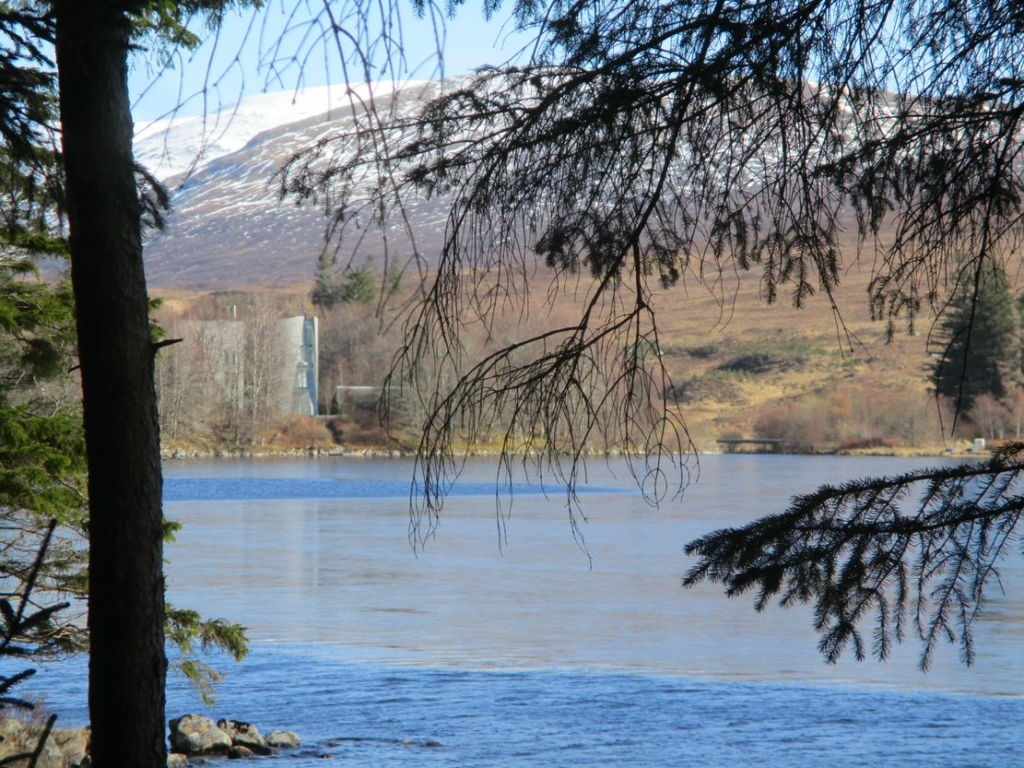
Loch Ossian, and the new Corrour Lodge (photo by author)
The Rausings acquired Corrour from the family of Sir John Stirling Maxwell, who had bought the estate in 1891. What were the Keppoch lands were previously sold by the Duke of Gordon in 1834 to John Walker of Crawfordton, Dumfrieshire, who made his fortune as a merchant in the West Indies. It was Stirling Maxwell who was responsible for the train station, allowing the rail company access to his land on the condition that they built a stop at Corrour. A horse and cart would then pick up his guests and take them to the boathouse – now the hostel – at the west end of Loch Ossian, where a steamer would transport them down the water to Maxwell’s hunting lodge at Corrour. Stirling Maxwell was of course the Tory politician and philanthropist who was heir to Glasgow’s Pollok estate. A keen antiquarian and founder member of the National Trust, he also came up with the ‘pioneering’ idea of planting conifers on peat bog, work which is attributed with encouraging the formation of the Forestry Commission in 1919. The trees that surround most of Loch Ossian, including a 25-acre rhodedendron wood, date from his time – William Roy’s 1747 map shows no forest cover around the lochside at all. The opposite is true of Loch Treig, Dòmhnall mac Fionnlaigh’s favoured hunting-ground, which is shown by the same source to be surrounded by trees, and you will find pine stumps in the now-boggy ground near Creag Ghuanach.
These days there are only small patches of scattered woodland around Loch Treig, one of which shelters the cabin of the loch’s most famous current inhabitant Ken Smith, the subject of Lizzie Mackenzie’s 2022 documentary, The Hermit of Treig. While working at the Station House restaurant at Corrour ten years previously, Mackenzie heard from estate ghillies about the hermit who lived in the woods. She subsequently learned how to make films in order to document the extraordinary life of her new friend Ken, who has now spent forty years living alone in the house he built himself.
Folk are wont these days to translate Loch Treig as ‘the lonely loch’, but trèig in this case would mean more along the lines of ‘relinquished’ or ‘abandoned’. It really isn’t such a lonely place: as well as the train line and the steady flow of hikers and mountain bikers along the tracks, the loch boasts not just one, but two resident hermits. I met the lesser-known hermit of Trieg, Dave, on the path when I walked down from the hostel. On my first visit I’d made friends with the legendary warden, Jan, and it was her who got me interested in the poem enough to come back for a second time. I told Dave she was asking for him. Dave has been there over a decade, and lives in a tent by the lochside year-round. He likes not to be bothered. He told me that since the release of the film, they’d had a few wee guys turn up with their tents wanting to be hermits too, mostly lasting no more than a couple of weeks.
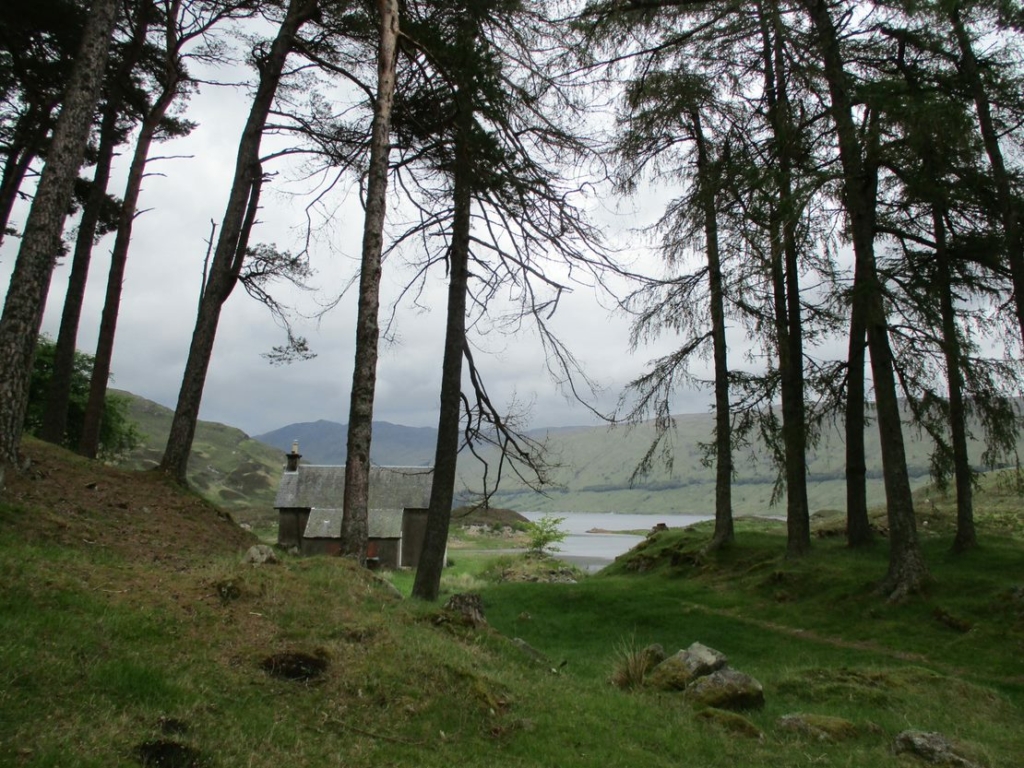
The semi-derelict Creaguaineach Lodge (photo by author)
Readers of previous articles will be aware this is not my usual turf – I generally regard anything south of Invermess as the Central Belt. To be perfectly honest, I find the landscape around here mostly charmless: estate-scarred, under-inhabited and now largely devoid of wildlife, you’ll see more action from Jan’s birds around the hostel than anywhere else for miles around. Like much of the country it reminds me of John Moriarty’s verdict on some parts of Ireland, where ‘the soul has been ploughed out of the land’. Centuries of over-use for sheep-faming, shooting estates and industry has resulted in a landscape far removed from that described by Dòmhnall mac Fionnlaigh in his poem – a place teaming with life, and where human history is woven into the land through place-names and story. John Macinnes spoke of the ‘poetic map’ which the bards drew with place-names, describing how ‘the native Gael who is instructed in this poetry carries in his imagination not so much a landscape, not a sense of geography alone, nor of history alone, but a formal order of experience in which these are all merged. The native sensibility responds not to “landscape” but to dùthchas.’ Loch Treig was the dùthchas of Dòmhnall mac Fionnlaigh, with his summer home at Creag Ghuanach at its heart. This end of the loch was a stopping point for drovers coming down through the Lairig Leacach, ‘slabby pass’, and had historically hosted locally important cattle markets. A hollow behind the settlement site is named, on the 1873 OS six inch first edition map, Slochd na Samhchaire, ‘hollow of tranquility’, evidencing its past as a place of rest and refuge.
It’s not obvious why Loch Treig would ever have been historically ‘relinquished’ or ‘abandoned’. Looking at the 19th-century OS map, not far from Craiguaineach Lodge itself there are numerous shieling names evidenced, mostly featuring the term ruighe, a hill-slope, with other names like Pàirc nan Laogh, ‘park of the calves’, also suggesting transhumance. There are also anthropotoponyms featuring personal names, from Tom Mhic Eòin (‘Iain’s son’s knoll’) at the south end to Allt Fhearghais (‘Feargus’ burn’) at the north. Most noticeable is the settlement of Lochtreighead and the nearby school, which now lie under water.
Loch Treig was dammed and flooded in the 1920s in what was then called the Lochaber Water Power Scheme, a venture by the British Aluminium Company that involved the digging of a 15-mile tunnel through the Nevis Range from Loch Treig to Fort William. Corrour Estate ends on the south side of the loch; the north side of Loch Treig, where Creag Ghuanach is located, is part of what is now known as Jahama Highland Estates, an area of 114,000 acres – essentially a hotch-potch of parcels of land bought up from the surrounding traditional landholdings for the hydro scheme. In 2016 the then-owners Rio Tinto Alcan put the estate and its Fort William smelter up for sale, and after a bid for community ownership by The East Lochaber and Laggan Community Trust was rejected, it was bought for £330m by GFG Alliance (now operating here as Jahama), a company with steelworks, mines, smelters and power stations from Australia to the Czech Republic. In 2021 the company attracted controversy for not fulfilling the obligations to the community that were part of a deal which saw returns to their investors guaranteed by the Scottish Government. The trust tried again in 2019 in what would have been the biggest community buyout in history, but as a community association faced the usual issues of funding and meeting compliance for a project on such a huge financial scale. They are apparently still in negociation with Jahama. A small, informal group who recently sought to renovate the old Creaguaineach Lodge into a community retreat with the agreement of the estate have also had their plans thwarted by lack of access to funds. Over in Corrour, Lisbet Rausing and her husband Peter Baldwin have just gifted the entire 57,000-acre estate to their son for his 30th birthday. It is unclear yet what the young laird’s intentions are for his new property.
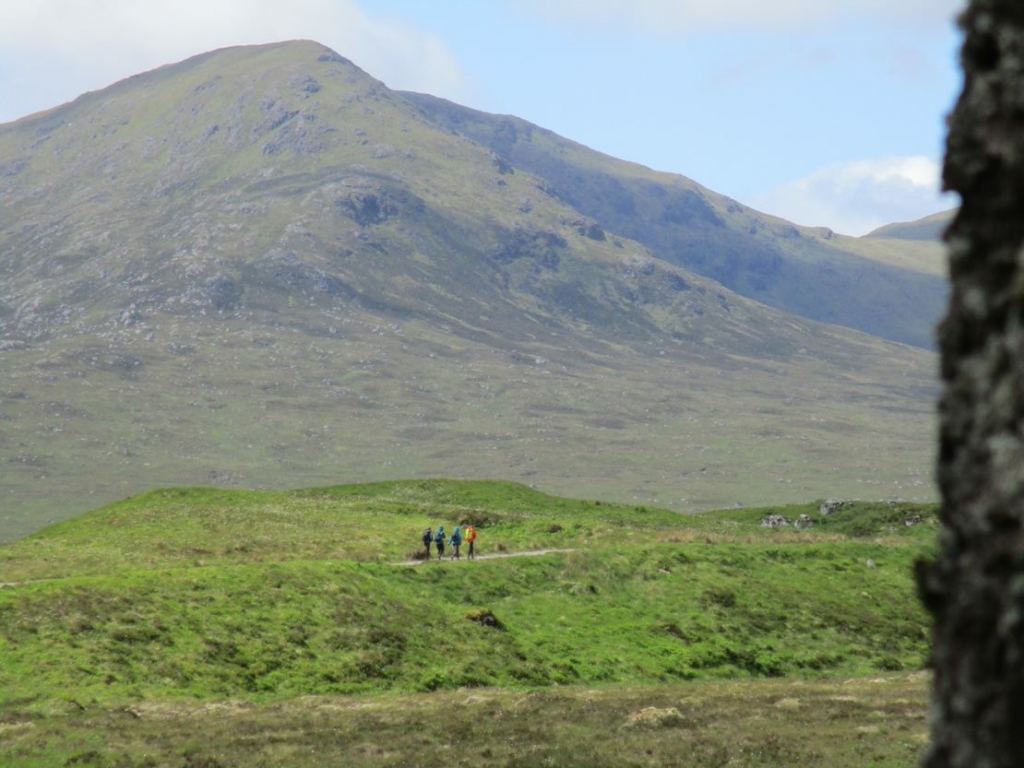
Walkers set off along the path from Loch Ossian (photo by author)
For those of you who have not tagged along for the whole trip: at Altnaharra we experienced the reality of the modern estate village; at Sandwood we looked at the artificiality of ‘wild land’; in St. Kilda we witnessed the construction of the ‘remote’; in Foilles we got a glimpse of how things might have been; and on Suilven we saw how gendered, neo-colonial attitudes perpetuate the depopulation of the Highlands. The situation in Lochaber illustrates how a place once the beloved dùthchas of Dòmhnall mac Fionnlaigh and so many others can be made derelict by money and power.
Why do we still tolerate this absurd situation? How has the cultural response inspired by this landscape over the centuries gone from ‘Rock of my heart, Creag Ghuanach’, to ‘it’s shite being Scottish’? Well, sometimes it is shite being Scottish. We are ruled by effete arseholes, it is a shite state of affairs to be in, Tommy, and all the fresh air in the world won’t make any fucking difference to that. Historically we have been shut out of great swathes of the land, and now only a lucky minority have access to a patch to call their own. We are not, though, ‘the most wretched, miserable, servile, pathetic trash that was ever shat into civilization’ – but we have been told it so often that many of us have come to believe it. As well as being put out of the land, we have been put out of our selves. In Decolonising the Mind, Ngugi wa Thiong’o writes of the effects of the ‘cultural bomb’ of language loss and deracination:
The effect of the cultural bomb is to annihilate a people’s belief in their names, in their language, in their environment, in their heritage of struggle, in their unity, in their capacities and ultimately in themselves. It makes them see their past as one wasteland of nonachievement and it makes them want to distance themselves from that wasteland.
One wasteland of nonachievement. A harsh, inhospitable landscape. A wilderness. And every time we characterise it as such ourselves, we are complicit: we shut ourselves out of the land, again and again. ‘It’s shite being Scottish’.
There has been much discussion recently about whether or not we are also ‘colonised by wankers’, which I will leave to those better qualified in that field. My focus is more on the colonial ideology that underpinned the relational feedback loops of subjugation and profit that built Empire at home and abroad. The infamous factor Patrick Sellar described the Sutherland people as ‘Aborigines shut out from the general stream of knowledge and cultivation’, yet so many of those he displaced went on to enact far greater horrors overseas. As Linda Tuhiwai Smith writes in Decolonising Methodologies, ‘they were all inheritors of imperialism who had learned well the discourses of race and gender, the rules of power, the politics of colonialism. They became the colonisers.’ The complexity of this is something we are still only beginning to understand. There are no clear distinctions when internal colonialism existed not just within the UK, but also within Scotland between the Lowlands and the Highlands; when Gaelic-speaking Highlanders became authoritarian estate officials who looked down on their charges as backwards, and clan chiefs tried to sell their own people into slavery; when folk from all over the country participated enthusiastically in colonial exploitation and atrocities abroad, whilst those who remained enjoyed – to varying extents – the material benefits of the country’s prosperity.
What has this got to do with history and place-names? As Tuhiwai Smith also says: ‘to resist is to retrench in the margins, retrieve what we were and remake ourselves’. Our indigenous languages across the world are key to this, with Gaelic literature and place-names providing a portal not just into an alternative version of our past, but into a way of being in our environment where we are not disenfranchised and disaffected but at home; a place in which huge tracts of land are not subject to the caprice of a single overprivileged man – or woman; a landscape in which there is a place for everybody, human and non-human. Is treasa tuath na tighearna.
Read the other articles in this series Gemma’s here.

This is the last in my series of articles for Bella Caledonia – I could have kept the stravaig going for a lot longer, but now have the small matter of a PhD thesis to finish. I just wanted to say thanks to everyone for all the lovely comments over the last couple of years – they really mean a lot.
I would also like to take the opportunity to advertise myself as now available for work! If anyone would like to employ me to write or do research, I’m available from the end of July and can be contacted at [email protected]. All my research outputs to date are available via links on my GU page: https://www.gla.ac.uk/pgrs/gemmasmith/.
Slàinte mhòr, a h-uile duine.
Gemma,
I wish you all the best with your research and endeavours. We shall need you in the next Scotland. It’s through knowledge and reason that we will return eventually to normal communities in the Highlands.
Mike in Killiecrankie
Gemma Smith’s pieces continue to be a real education.
Rivetting stuff. Thanks.
Mòran taing airson na sgrìobh sibh.. thank you for your scholarship and hope. The more you know and research about the vast universe of cultural treasure in Gaelic, the more painful it is to come up against the crushing lack of concrete hope for change and renewal, the vast loss, ignorance, the totality of indifference, the completeness of powerlessness. Knowledge is pain, hope and the near certainty of failure of its fulfilment is painful – I suspect this also has much to do with the shaping of attitudes at a semi-conscious pschychological level as other factors, and sadly our past, present and future at a micropersonal and populational level.
Thanks so much for this wonderful piece, and all those that came before it. I look forward to re-reading them all.
Really great article and research. The massive effect of sheep grazing cannot be underestimated. And great point towards the end about ‘wilderness’ and how it perpetuates the idea it is totally inhospitable.
What that makes me wonder is what the landscape was like when it was a lot more (apparently) ‘hospitable’. I am sure there must be scholarship on this. Reading Johnson’s Highland tour in the late 18th century he already describes a treeless, desolate ‘wilderness’ and people living in dire poverty. But what was it really like in the time Gemma is imagining, when it was ‘a place teaming with life, and where human history is woven into the land through place-names and story’ (and when was this exactly?).
The one caveat I would add is what was it really like for those people when it was teeming with life? It must always have been pretty harsh given the climate and geography so the romantic view of how people lived / survived needs to be avoided. Maybe some of those (non-political) changes that depopulated and devastated the area that we now so regret were inevitable as we grew to like the comforts and ease of living advances in technologies and knowledge brought down the centuries, making the tough life in the wilderness no longer tenable.
On a personal level I do actually quite like the real desolate wilderness of Rannoch Moor as it gives one a sense of awe and perspective somehow. It is quite grounding.
Hi Niemand, thanks very much for the comments. I’d say the best source for answers to your questions is probably the poem itself, which dates from the 16th century. There’s no full translation online sadly, but Pat Menzies’ book is great, and available here: https://www.gaelicbooks.org/explore-the-shop/poetry/traditional-poetry/oran-na-comhachaig. See also Moladh Beinn Dóbhrain by Duncan Ban MacIntyre.
Re: the ‘harshness’ of life back then – I previously spent three years working in a call centre and over 20 years on and off in hospitality in the city, and I sure wasn’t writing poetry about it. I think views of what constitutes a ‘tough life in the wilderness’ are probably relative!
as a fellow former call centre worker, couldn’t have put it better myself, ach bha sibh fhèin fad nas dioplomaitigich na mar a bhithinn fhèin ‘s mathaid. Apart from general lived experience of people who lived in and loved their homes, versus unsympathetic outside commentators of the era who understood little of either Gaelic or the areas, there really is a vast mountain of song and poetry where the pain and loss people felt after having left their homes is expressed in a near endless variety of ways. Life had a terrible harshness to it at that time in cities or emigrant target countries as well, and arguably still does.. Honestly don’t know if they inspired poetry and song describing their beauty to quite the same minutely detailed extent, and perhaps that’s telling enough – or not..
Many thanks Gemma, I will buy that book! And you are right about the relativeness of harshness and the fact the poem reflects something that would not be there to reflect on in how we live today where another kind of harshness, of a potentially much worse sort, has replaced it. Maybe we have sacrificed that for the relative comforts of modern living whereby connection with the natural world has not just diminished but it has become ‘other’ and hence seen as desolate wilderness.
And to add regarding the whole re-wilding business, a friend who has been involved in that has written how to really make that meaningful we have to think first about re-wilding ourselves. And maybe the time and people you are researching simply had that by default.
Think you’ve hit the nail on the head there with that one Niemand – but reaffirming Gaelic at the heart of ‘rewilding ourselves’ has some pretty challenging historical overtones unfortunately..
I loved reading this. Best of them all. Thanks Gemma.
Thanks Gemma, enjoyed your Creag Ghuanach – great MacInnes quotes, and agree that the ‘pseudo-Ossianic lore’ of Lochaber comment reveals a lack of research, to say the least.
I read through Gemma’s other articles (had read some before) and they are very thought-provoking and as everyones says, fascinating and so well written.
The one on Sandwood Bay talks about imagining what it might be like now if human habitation had continued there. Gemma paints a picture of a quiet, picturesque seaside village. It is an attractive image but then it does not mention roads, cars, lorries, modern shops and light industry and all the other things needed for a modern community to survive.
Gemma therefore poses a really challenging dilemma: wild and empty Sandwood in which its very emptiness and lack of humans is what we like about it (but also the sense it was once not so empty but in a time when ‘modernity’ does not impinge on our imagination; instead we think of an ancient community living in harmony with nature and of a beautiful lost Gaelic culture), versus a continually inhabited place which now might be much like other small more ‘remote’ West Coast seaside villages, which is potentially equally appealing. The indigenous Gaelic element of any such village now would be in doubt I suspect though – would it just be another tourist / retirement place?
I feel pretty torn as I do like these far flung spots with no roads, wildlife left alone and few people about. Knoydart for example, is special because of that but then the politics and iniquities of the past are why it is like it is now I suspect.
A wonderful series of articles – thank you. They would make a great book. I am very interested in the ideas that you introduce toward the end of this piece, around the “colonial ideology that underpinned the relational feedback loops of subjugation and profit that built Empire at home and abroad” – for example, indigenous Highlanders who were exiled to North America and Australia and participated in the destruction of the way of life of indigenous peoples in those lands. Have you written more on that theme, that I could follow up on? Or is there work by other researchers that would be relevant?